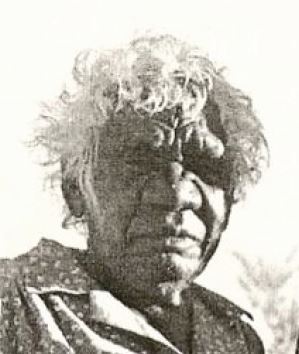Molly Rogers was born in 1930 in the bush at Japirnka, her country, south of Fitzroy Crossing in the Great Sandy Desert. Her Aboriginal name is Walka. She is the eldest of four children. Her mother and father passed away in country called Timber Creek and she was brought up by her grandmother and her cousin, Peter Skipper’s grandmother. Some time later she met her promised husband who took her to Kumpujarti and then to a succession of different sites including Mangarla, Puluwala jila. Later she moved to Bayulu where she attended Karrayili Adult Education Centre and began to paint. Her work was first included in a Bayulu community exhibition at Indigenart, Subiaco in 1997.
“Long time ago when I was living in the bush we use to go hunting for these animals, wirkla (sand goanna), lungkara (blue tongue lizard). When we light the fire the smoke brings the animals out its easy to catch it, like minyngajurru (golden bandicoot), minyjarti (great desert skink) also ngiyari (mountain devil) and raltariyi (kangaroo). I was born in my country called Japirnka (waterhole), it’s south from here to the Great Sandy Desert that’s where my mother had me. Then she passed away in this country called Jurnjawarla (waterhole). I am the oldest then Huey Bent, then Jimmy Wora, then my young sister Patsy Bangu only four of us. The other three weren’t born where I was, my mother had to travel a bit farther to a place called Jarlkurru (waterhole). That’s where they was born also they haven’t seen our mother and father since they were small kids when they both died, I’m the only one who knew them. Our Grandmothers had to look after them until I grew up. Our Grandmother died not far from Lumpa Lumpa (waterhole). There’s a windmill not very far from there also this is where our mother and father died in this country called Timber Creek.” (Molly Rogers, 1996)
Molly Rogers was born in 1930 in the bush at Japirnka, her country, south of Fitzroy Crossing in the Great Sandy Desert. Her Aboriginal name is Walka. She is the eldest of four children. Her mother and father passed away in country called Timber Creek and she was brought up by her grandmother and her cousin, Peter Skipper’s grandmother. Some time later she met her promised husband who took her to Kumpujarti and then to a succession of different sites including Mangarla, Puluwala jila. Later she moved to Bayulu where she attended Karrayili Adult Education Centre and began to paint. Her work was first included in a Bayulu community exhibition at Indigenart, Subiaco in 1997.
“Long time ago when I was living in the bush we use to go hunting for these animals, wirkla (sand goanna), lungkara (blue tongue lizard). When we light the fire the smoke brings the animals out its easy to catch it, like minyngajurru (golden bandicoot), minyjarti (great desert skink) also ngiyari (mountain devil) and raltariyi (kangaroo). I was born in my country called Japirnka (waterhole), it’s south from here to the Great Sandy Desert that’s where my mother had me. Then she passed away in this country called Jurnjawarla (waterhole). I am the oldest then Huey Bent, then Jimmy Wora, then my young sister Patsy Bangu only four of us. The other three weren’t born where I was, my mother had to travel a bit farther to a place called Jarlkurru (waterhole). That’s where they was born also they haven’t seen our mother and father since they were small kids when they both died, I’m the only one who knew them. Our Grandmothers had to look after them until I grew up. Our Grandmother died not far from Lumpa Lumpa (waterhole). There’s a windmill not very far from there also this is where our mother and father died in this country called Timber Creek.” (Molly Rogers, 1996)
![Australian Indigenous (Aboriginal and Torres Strait Islander) artwork by WALKA MOLLY ROGERS of Mangkaja Artists. The title is Japingka. [201/12] (Atelier Artist Acrylic, 250gsm Velin Arches Paper)](https://media.redotgallery.com/stockroom/gallery/j/artwork/w/japingka-3197-MEDIUM-3.jpg)
![Australian Indigenous (Aboriginal and Torres Strait Islander) artwork by WALKA MOLLY ROGERS of Mangkaja Artists. The title is Japirnka. [wp549/05] (Acrylic on paper)](https://media.redotgallery.com/stockroom/gallery/j/artwork/w/japirnka-608-MEDIUM-3.jpg)
